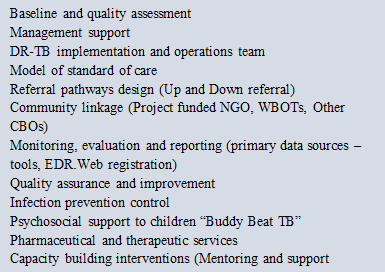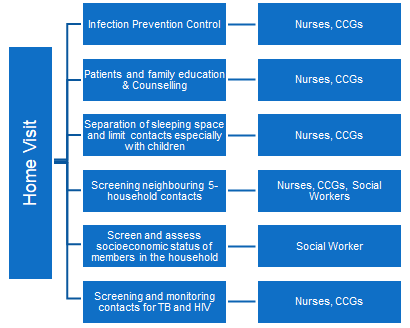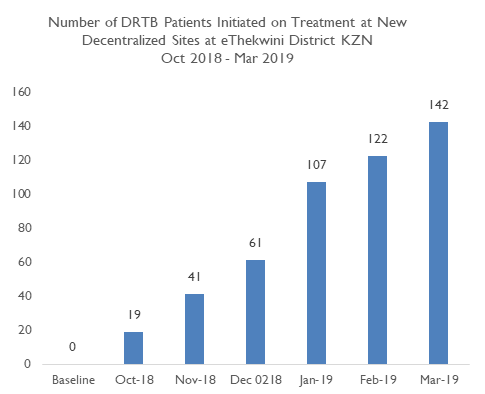Research Article - (2023) Volume 9, Issue 3
Community Infection Control in the Context of Injection-Free Regimen and Decentralised Ambulatory Care: Six Month Follow of DR-TB Cases in Decentralised Facilities eThekwini District, South Africa
Joven Jebio Ongole1*,
Sharon Fynn2 and
Gregory Jagwe1
1Department of Physician, University of Pretoria, Pretoria, South Africa
2Department of Medical Science, University of Pretoria, Pretoria, South Africa
*Correspondence:
Joven Jebio Ongole, Department of Physician, University of Pretoria, Pretoria,
South Africa,
Email:
Received: 09-Oct-2019, Manuscript No. IPJPIC-19-2336;
Editor assigned: 14-Oct-2019, Pre QC No. IPJPIC-19-23369(PQ);
Reviewed: 28-Oct-2019, QC No. IPJPIC-19-2336;
Revised: 08-May-2023, Manuscript No. IPJPIC-19-23369(R);
Published:
05-Jun-2023, DOI: 10.21767/2049-5471.20.03.20
Abstract
Introduction: In July 2018, South Africa introduced the injection free bedaquiline based treatment regimen to replace the kanamycin-based regimen for Drug-Resistant (DR) TB. With support from the USAID Tb South Africa project, eThekwini district with the highest burden of DRTB in South Africa rapidly decentralised DR-TB care from an initial three centralised admission TB Hospitals to 18 peripheral districts, community health centres and clinics to improve access while focusing on ambulatory care as opposed to institutionalized hospital based care. The ambulatory model of care meant patients where managed within their households and thus communities while on treatment. An effective infection control in the household and community was implemented to prevent and control infections among families and close contacts. After six months, 98% of the patients remained in ambulatory care and no transmission recorded among close contacts. This publication shares interventions used and early outcomes from this intervention.
Methods: A DR-TB care package was developed and adapted to each of the identified decentralised facilities and implemented in three layers. This include an orientation package for facility leadership to ensure appropriate governance, leadership and management for DRTB care at facility level, DRTB care package for DRTB providers and facility teams (DRTB teams) and a DRTB service package for the community functionally linked to the facility interventions. Training, systems mentorship and support supervision were the main interventions implemented.
Results: Between Oct 2018-Mar 2019, 16 of the 18 decentralised sites in eThekwini district adapted the DRTB care package and constituted their DRTB teams. Within the six months a total of 142 patients were initiated on treatment of which 139 (98%) remained in ambulatory care by the end of March 2019. Three patients with advance disease died in the first month of enrolment. Of the 142 index patients, 211 contacts of were screened (44% at home 56% at the facilities), 85% of the patients culture converted in the first month, 3 contacts were diagnosed with TB (2 drug sensitive, 01 drug resistant). No transmission occurred in contacts after enrolment into DRTB care.
Conclusion: The possibility of transmission of infection to DRTB contacts exist among patients placed in ambulatory care. However, among the patients that was provided with the DRTB care package in eThekwini District there was no transmission associated with the index patients. It is thus recommended that infection control interventions that starts from facility is extended to the communities using systematic and applied interventions specific to the communities and facilities be scaled as cost effective and efficient intervention for DRTB in high burden locations.
Keywords
TB; Infection control; Multi-drug resistant tuberculosis; Kanamycin; Community health
Introduction
South Africa is one of the countries with the highest TB
caseload in the world. According to WHO 2018 report, the
country notified 227224 cases of drug sensitive TB and 7700
of drug resistant TB in 2017. The country piloted a
decentralised MDR-TB care programme in 2008, in Kwa Zulu
Natal and Western Cape, the two provinces with the highest
incidence of TB disease. The successes and lessons learnt in
these piloted programmes, as well as international
experience, informed the national policy framework on
“decentralised” and “deinstitutionalised” management of
Multi-Drug Resistant Tuberculosis (MDR-TB) services launched
in 2011. Since then South Africa has had a remarkable
progress in operationalising the national policy framework of
the decentralised MDR-TB services with over 651 MDR-TB
treatment initiation sites 1 decentralized to date and the
number of patients treated for MDR-TB increased from 5,313
in 2010 to 11,119 in 2016. The treatment success rate
improved from just below 40% to 54% (2014 cohort). The
implementation of the decentralisation programme is
province specific, however, aligned to the national policy
framework on decentralised and deinstitutionalised
management of MDRTB.
Further, South Africa introduced the “injection free”
bedaquiline based DR-TB treatment regimen that replaced
the kanamycin-based regimen in July 2018. Shortly after this
policy change, eThekwini district with the highest burden of
TB, embarked on an aggressive expansion of DRTB care to
improve both geographic and technical access, and availability
at local health facilities. This was done in line with SA policy
on decentralisation and institutionalisation of DRTB in the
country. The district rapidly scaled DRTB care from the initial
three sites (one centralised centre of excellence and two
decentralised) with admission facilities to 16 facilities without
admission facilities. This publication shares the approach used
to strengthen infection control in the facility, homes and
community in the context of ambulatory care. The goal was to
prevent infection among close contacts through the provision
of DRTB package of care, home visits and partnership with
local community-based organisations and families.
Materials and Methods
The DR-TB care was introduced in decentralised facilities and
implemented in three layers. Orientation package for facility
management, DRTB care package for DRTB providers (DRTB
teams) and DRTB service package for the community. Training, mentorship and support supervision were the interventions
implemented.
Approach
To provide community infection control, four facility
customised interventions were implemented.
The DRTB Care Package
The operational package defines the roles of site, providers
and teams as a whole based on the conventional health and
community systems strengthening approach, including
strengthened governance, management, leadership and
coordination of DRTB care. The DRTB teams are provided with
skills and experience to conduct DRTB clinical audit on regular
basis. The package provides for the education and
empowerment of the index patient on DRTB, ambulatory
care, HIV care (if applicable), infection control and interaction
with contacts [1]. This package has ten components and
targeted the facility, management, health care workers,
specifically DRTB team and community health workers and
the index patient. The intervention package provided facility
managers with skills and knowledge of DRTB outline specific
roles in implementing DRTB and identified resources required
to support DRTB implementation [2]. It provided DRTB
implementation teams (physicians, nurses, social workers,
dieticians, physiotherapist, pharmacist, clinical associates,
data capturers and community health workers) capacity to
strengthen DRTB services; systems orientated operational
package to systematically manage MDRTB patients, utilise
available resources and infrastructures, develop site-specific
functional and bi-directional referral pathways that enabled a
continuum of response based on the DRTB care cascade from
above site and into the community. The package also enabled
information management through appropriate
documentation in the clinical records, correct registration and
reporting and translating manual records into an electronic
Drug-resistant web-based register (Figure 1) [3].

Figure 1: The DRTB care package.
The Home Visit
Home visits provide a crucial step in controlling infection
control in the household and immediate neighbourhood. This
activity is coordinated by a TB focal nurse in the team and
involves nurses, social worker and community health workers.
Six critical activities are implemented, which includes
infection control in the household, separation of sleeping
space for patient, screening and monitoring of contacts for TB
and HIV, assessment of social and economic status and needs,
education and counseling of family and screening of
neighbours. The assessment is conducted in the household,
and at least five neighbouring houses to the north, south,
west and east. This is done in accordance with the
department of health guidelines on infection control in the
urban community setting and different team members play
roles depending on the intervention (Figure 2) [4].

Figure 2: The home visit.
Partnership and Strengthening of Structures in the
Community
This intervention is used for tracing DRTB cases lost to followup,
contact tracing, infection control, screening and
monitoring contacts for HIV and TB, family counselling and
education and screening neighbours and ensuring separation
of sleeping spaces at home [5]. In 12 facilities, the DRTB
teams included Community Health Workers (CHWs) who
worked within the community to ensure the continuity of
care. In two sites, the Community Caregivers (CCGs) from
community-based organizations linked the facility services in
the community they serviced. Both CHWs and CCGs have the
same scope of work [6]. Those recruited by Government and
place at facilities are referred as CHWs and those based in the
community organisations are referred to as CCGs. Thus, the
approach remained similar whether the CHWs or CCGs were
deployed to ensure continuity of care in the communities.
Coordinated by TB focal nurse, the DR-TB cases for tracing and
home visits are identified by the facility and list given to the
CCGs/CHWs during the weekly briefing and debriefing
session. During these sessions, the tasks were assigned, and
feedback is provided [7].
Results and Discussion
Sixteen of the planned 18 DRTB sites in eThekwini district
were functionally decentralized between October-December
2018. Of the 16 facilities, four were hospitals and 12 Primary
Health Care (PHC) centers. Cumulatively, by the end of March
2019, a total of 142 patients had been initiated on treatment
with a retention rate of 98% (2 died in the first month, one
defaulted at 4 months) [8]. Despite four sites not having
participated in the home visit, 91% of the enrolled patients
were visited at home and provided DRTB service package of
care for a home visit [9].
By March 2019, these new decentralised sites initiated and
monitored 142 patients, with 98% of them placed on
ambulatory care [10]. The patients remained in their homes
and communities throughout the treatment period.
Community infection control was the central in ambulatory
care and was provided implemented from the facility through
to community. The 6 months result is summarized in the Table
1 below [11].
| Indicator |
Number |
Percent |
| Total DRTB diagnosed |
142 |
- |
| No. initiated DRTB treatment |
142 |
100% |
| No. admitted |
3 |
2% |
| No. retained on treatment |
139 |
98% |
| No. of patients with cough suppressed in the first week |
119 |
84% |
| Cough suppressed in first month |
136 |
96% |
| Culture conversion in first month |
121 |
85% |
| No. conducted home visits |
129 |
91% |
| No. of contacts screened |
211 |
100 |
| No. of contacts screened at home |
92 |
44% |
| No. of contacts screened at the facility |
119 |
56% |
| No. of contacts diagnosed DSTB |
2 |
0.90% |
| No. of contact diagnosed DRTB |
1 |
0.45% |
| No. of contacts diagnosed infected after initiating DRTB treatment in 3-6 months |
0 |
0% |
Table 1: Findings in DRTB patients initiated at decentralised sites in 3-6 months.
Decentralisation in eThekwini District has increased access to
care for MDR-TB patients and expanded MDRTB care into
communities [12]. DRTB care expanded to 16 of the 18 health
facilities and improved access to DR-TB treatment, care and
support from the local facility by 89% and ambulatory care to
98% of patients. Unlike PHCs, the hospitals do not have a
direct link to the community and lack CHWs in their staff
compliment to conduct the home visits [13]. Thus, the
hospitals refer patients to the feeder clinics (Community
Health Centre and Clinics), who in turn take responsibilities to
conduct home visits. Access to DRTB service package of care
to the family and community was important for infection
control interventions and retention of patients into care.
The risk of transmission of TB to contacts was very low
and all three contacts (one drug-resistant and two drugsensitive
TB) who were infected, occurred prior to
treatment of index patients [14]. The transmission,
therefore, occurred prior to the initiation of treatment. The
contacts were followed over 3-6 months and no further
transmission have been registered. The absence of
transmission in patients on treatment is explained by
several factors. First, all patients who were diagnosed
were placed on treatment. Since the diagnosis is by
Genexpert, these patients were initiated early on treatment
and therefore provided early infection control interventions
(Figure 3) [15].

Figure 3: The number of DRTB patients initiated on treatment
at new decentralized sites at eThekwini district.
Secondly, these patients received injection free regimen of
seven drugs, which comprise four core drugs (bedaquiline,
clofazimine, levofloxaccin, linezolid) and three companion
drugs (high dose isoniazid, ethambutol, pyrazinamide). All the
core drugs in the regimen are bactericidal and sterilising and
in addition, bedaquiline actively penetrates lung cavities.
Along with companion drugs, the regimen kills and clears
bacilli from the lungs in a few days and renders patients noninfective
despite coughing . The regimen suppressed cough in
84% of patients in the first week and 85% of the DR-TB
patients culture converted in the first month. The early
suppression of cough as well as the culture conversion played
an important part in the curtailing transmission to contacts.
Secondly, implementing DRTB home visit service package
provided the families with interventions like infection control,
family education and counselling, contact screening and
separation of sleeping space that reduced the risk through
behavioural change and practices. Lastly, the home environment provided an open space for the family to spend
time outside. The outside environment is supported by
nature, specifically wind and sunlight to disperse and kill
bacilli respectively. The risk of transmission of TB is
significantly reduced in a home setting and encourages
ambulatory care [16].
Conclusion
The results confirmed that the risk of transmission of
infection is low among DR-TB patients in ambulatory care. The
implementation of DRTB service package of care from the
facility (early diagnosis, prompt initiation of treatment,
infection control etc.) to DR-TB home visit service package in
the house household and community are complementary in
ensuring a reduction in the transmission of infection.
Therefore, decentralised DRTB services should focus on
ambulatory care, but ensure infection control through a
specific facility and home-based care package. The package
provides holistic DRTB care by building the capacity of the
community and health institutions, health care workers,
patients, families and communities.
Recommendations
We recommend systematic implementation of DRTB care
package and DRTB home service care package interventions
to achieve community infection control in ambulatory care
settings. This approach strengthens both facility and
community systems through a series of locally adapted
interventions that control TB infection and reduced
transmission to contacts.
Conflict of Interest
None.
References
- Abbas S, Kermode M, Kane S (2020) Strengthening the response to drug-resistant TB in Pakistan: A practice theory-informed approach. Public Health Action. 10(4):147-156.
[Crossref] [Google Scholar] [PubMed]
- Abdool KSS, Churchyard GJ, Karim QA, Lawn SD (2009) HIV infection and tuberculosis in South Africa: An urgent need to escalate the public health response. Lancet. 374(9693):921-933.
[Crossref] [Google Scholar] [PubMed]
- Andrews JR, Stout JE (2015) Treating multidrug-resistant tuberculosis in community settings: A wise investment. Int J Tuberculosis Lung Dis. 19(2):127-127.
[Crossref] [Google Scholar] [PubMed]
- Atun R, Menabde N (2008) Health systems and systems thinking. Health systems and the challenge of communicable diseases: Experiences from Europe and Latin America. Open University Press, Maidenhead, pp. 121-140.
[Google Scholar]
- Atun R, Weil DE, Eang MT, Mwakyusa D (2010) Health-system strengthening and tuberculosis control. Lancet. 375(9732):2169-2178.
[Crossref] [Google Scholar] [PubMed]
- Atun R (2012) Health systems, systems thinking and innovation. Health Policy Plan. 27:4-8.
[Crossref] [Google Scholar] [PubMed]
- Barbrook-Johnson P, Penn AS (2022) Systems mapping: How to build and use causal models of systems. Springer Nature. 186.
[Google Scholar]
- Barrett S (2004) Implementation studies: Time for a revival? Personal reflections on 20 years of implementation studies. Public Admin. 82:249-262.
[Crossref] [Google Scholar]
- Bassili A, Fitzpatrick C, Qadeer E, Fatima R, Floyd K, et al. (2013) A systematic review of the effectiveness of hospital and ambulatory based management of multidrug-resistant tuberculosis. Am J Trop Med Hygiene. 89(2):271-280.
[Crossref] [Google Scholar] [PubMed]
- Basu S, Andrews JR, Poolman EM, Gandhi NR, Shah NS, et al. (2007) Prevention of nosocomial transmission of extensively drug-resistant tuberculosis in rural South African district hospitals: An epidemiological modelling study. Lancet. 370(9597):1500-1507.
[Crossref] [Google Scholar] [PubMed]
- Bateman C (2015) Tugela Ferry’s extensively drug-resistant tuberculosis-10 years on. South African Med J. 105(7):517-520.
[Crossref] [Google Scholar] [PubMed]
- Beland D, Ridde V (2016) Ideas and policy implementation: Understanding the resistance against free health care in Africa. Global Health Gov. 10(3).
[Google Scholar]
- Bennett S, Frenk J, Mills A (2018) The evolution of the field of health policy and systems research and outstanding challenges. Health Res Pol Sys. 16(1):1-6.
[Crossref] [Google Scholar] [PubMed]
- Berhanu R, Schnippel K, Mohr E, Hirasen K, Evans D, et al. (2016) Early outcomes of decentralized care for rifampicin-resistant tuberculosis in Johannesburg, South Africa: An observational cohort study. PLoS One. 11(11):p.e0164974.
[Crossref] [Google Scholar] [PubMed]
- Berlan D, Buse K, Shiffman J, Tanaka S (2014) The bit in the middle: A synthesis of global health literature on policy formulation and adoption. Health Pol Plan. 29(suppl_3):23-34.
[Crossref] [Google Scholar] [PubMed]
- Berwick DM (1998) Developing and testing changes in delivery of care. Ann Internal Med. 128:651-656.
[Crossref] [Google Scholar] [PubMed]
Citation: Ongole JJ, Fynn S, Jagwe G (2023) Community Infection Control in the Context of Injection-Free Regimen and
Decentralised Ambulatory Care: Six Month Follow of DR-TB Cases in Decentralised Facilities eThekwini District, South Africa. J
Prev Infect Cntrol. 9:010.
Copyright: © 2023 Ongole JJ, et al. This is an open-access article distributed under the terms of the Creative Commons
Attribution License, which permits unrestricted use, distribution, and reproduction in any medium, provided the original
author and source are credited.




